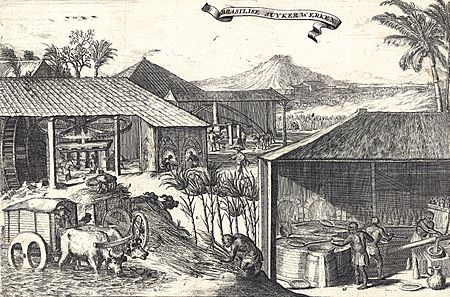Engenho facts for kids
An Engenho (pronounced "en-JEN-yoo") is a Portuguese word from the colonial era. It describes a sugar cane mill and all the buildings and land that went with it. In Spanish-speaking countries like Cuba and Puerto Rico, these places were called ingenios. Both words mean "engine," coming from the Latin word ingenium.
The word Engenho usually meant just the mill itself. But it could also describe the whole area. This included the land, the mill, the people who farmed, and those who knew how to make sugar. It also included the sugar cane crop itself. A very large estate was needed. This was because a huge amount of work was required to turn raw sugar cane into refined sugar, molasses, or rum. These large sugar estates were very common in Brazil, Cuba, and the Dominican Republic, as well as other Caribbean countries. Even today, Brazil is one of the world's biggest producers of sugar.
Sugarcane in Brazil
Sugarcane was not native to Brazil. The Portuguese brought it there in the mid-16th century. They already had a leading sugar industry in Madeira. But they wanted to create another powerful sugar production base in Brazil.
At first, local indigenous people grew and produced the crop. They traded it for other goods. Over time, this relationship changed. The indigenous people were forced into slavery. Around the world, sugar was becoming very popular. It started to replace honey as a main product. This was because more sugar was available, and prices became lower.
Sugar became a valuable item on the world market. Its production relied on forced labor and a special industrial setup. These were both essential to make sugar. The native people did not easily accept slavery. They were also hard to control. As the demand for sugar grew, these issues led to the import of enslaved Africans.
The Engenho: A Sugar Factory
In the late 1700s and early 1800s, there was a big increase in exports. This led to a huge boost in the production of sugar and other sugar cane products. The supply of sugar kept growing. This happened even as slavery became illegal in some parts of the world. However, the slave trade continued into the late 19th century.
A slave revolt in Haiti allowed Brazil and other colonies to become the top sugar producers. In 1792, Haiti made half of the world's sugar. But after the rebellion, they produced almost none the next year. Sugar cane work mainly happened on large farms called Engenhos.
An Engenho was a farming establishment. It had all the machines and resources needed to refine sugar from sugar cane. These places usually had a mill to crush the cane. They also had large boiling pots (cauldrons) and distilleries. They got their name because of all the parts used to make sugar cane into products for export.
Engenhos were quite advanced for their time. They combined manufacturing, chemistry, and farming to mass-produce sugar. This new type of industrialized farm needed many working parts to keep it going. An Engenho needed a field, a workshop, a refinery, and an office just to make the sugar. This list doesn't even include the power needed or the enslaved people required.
To run an Engenho, special enslaved people and servants were necessary. The person in charge (the overseer) had to be a free white person. The enslaved people bought for the Engenho needed to be strong field workers. Some were already familiar with the sugar production process. They were sometimes brought from Sao Tome in Africa. This was because Sao Tome had a history as a major sugar producer. This meant workers from there often had the skills needed for sugar cane production.
These large sugar plantations needed a new way of dividing labor. This applied to both the overseers and the enslaved people. The overseer had power on the plantation, but not total power. The plantation owner was the most powerful. For example, the overseer could not punish enslaved people however he wanted. He had limits. His main job was to make sure all supplies were there. He also kept a list of what the owner needed to buy. The overseer had to keep the enslaved people working and cared for. He also made sure the steps in sugar production were done correctly.
The sugar-making process needed enslaved people for cutting, carrying, boiling (evaporation), and crystallization. All of this had to happen very quickly. This was because of the nature of the crop. To keep the Engenho running, a huge increase in workers was needed. To make sugar, the process had to be continuous. It went nonstop from cutting in the field to the final export. An error at any stage could cause big problems. It could ruin a whole batch of the harvested crop.
Sugar cane would spoil within 24 hours of being cut. So, time was very important. Workers could not afford to make mistakes. Sugar production and enslaved labor were completely linked. They depended on each other for sugar cane farming and production. Making and exporting sugar now relied on the Atlantic slave trade.
What made the Engenho different was that everyone involved was needed. From the enslaved field worker to the chief overseer, each person had to do their part. This made the plantation successful. Also, the owner could not just buy any enslaved person. They needed to be skilled and knowledgeable about their specific role in the sugar cane process. Getting this level of knowledge was not easy. Training cost money, time, and resources. It could take a year or more to learn sugar production. This was because it takes a long time for sugar cane to grow and ripen.
See also
 In Spanish: Ingenio azucarero para niños
In Spanish: Ingenio azucarero para niños
- Trapiche



